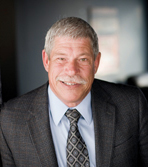Refer Madness

D.A. Drouillard.
Photo by Geoff Johnson
Alan Fanger doesn’t remember whether it was four phone calls or five, but they came in rapid succession. Each person wanted legal advice, and by the end of the last conversation, Fanger was frustrated—and behind on his work.
“I found myself struggling with how to balance the need to be empathetic, and to demonstrate that I care and that I am here to help, against the business realities of running a solo practice,” says the Newton, Mass., litigator.
Yet Fanger realizes the situation may have been unavoidable. That’s because each caller was a referral, sent specifically to him by a colleague or former client. “I feel a supreme obligation to any referral source to make the first contact with any prospective client as meaningful as it possibly can be,” he says. But after so many hours of phone time, “I found myself saying, ‘Was this the right way to go about this? What just happened to half my day?’ ”
When he discussed the issue with colleagues, both in person and through posts on Solosez, the ABA General Practice, Solo and Small Firm Division’s e-mail discussion list, he got an earful.
“There have been as many opinions on the subject as there have been people in the room discussing it, which I think tells you how vexing an issue it is,” he says. “And the answer that I came up with is that there is no precise answer.”
Some suggested charging a consultation fee before engaging in any discussion—referral or no; others advocated passing every initial call to a paralegal for prescreening.
Omaha, Neb., lawyer D.A. “Duke” Drouillard, however, has perhaps the most interesting twist on the situation: Take the call and approach it as advertising rather than intake.
“The way you treat that one [potential] client is the best advertising you could do, whether or not you can help them with the problem,” Drouillard says. “People spend so much time worrying and stressing about advertising, and here you have someone in front of you who could influence 10 people or 100 people.”
Drouillard does charge consultation fees, but he nearly always waives them for referrals. He handles initial calls and in-person consultations himself, relying on strategic questioning to tease out relevant facts in a timely manner.
But he’s found that when potential clients feel listened to, they often pay the referral forward. “I am sending them back out there to sell for me,” he says.
Of course there also can be a time when enough is enough, especially if there’s a single lawyer who’s continually referring dogs, duds and crackpots, says Carolyn Elefant, a lawyer in Washington, D.C., who authors the popular My Shingle blog. “If it happens more than three times, give them a call and say, ‘I appreciate your efforts, but here’s what I do. …’ ”
A PROACTIVE APPROACH
Even better, Elefant suggests, the referring lawyer could place a courtesy call, giving a heads-up on what’s coming down the pike.
She does this, and she believes it helps create a win-win situation for everyone involved. “From my perspective, it lets the other lawyer know I am thinking of them and keeping them in mind, which can increase the likelihood of cross-referrals, and it also ensures that the client will be taken care of.”
David A. Silverstone would just appreciate some vetting on the sending end. While he generally takes a hard-line approach to intake—using an assistant as a gatekeeper and always charging a consultation fee—the Hollywood, Fla., litigator does admit to loosening the reins for referrals.
“There are many small relationships that make up my practice, and they are very important to keep up,” he says. “You hope that the other lawyer will prescreen them, that it’s a higher level of a phone call coming from an attorney referral.” But that’s not always what happens, he adds. “I have been referred some where I was like, ‘Did you want to inject a little humor into my day?’ ”



